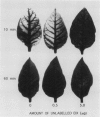Abstract
125I-Labeled ethylene biosynthesis-inducing xylanase (EIX) was used to study the movement of this protein in tobacco (Nicotiana tabacum) tissues. A biologically active 125I-labeled EIX was obtained using chloramine-T as the oxidizing agent. Labeled EIX was detected in the far most edges of the leaf 5 min after it was applied to the petiole of a detached leaf. EIX was distributed uniformly throughout the leaf, including the mesophyll area within 5 to 15 min, after which there was only little change in the distribution of radioactivity in the leaf. 125I-Labeled EIX was extracted from treated leaves, and EIX translocation in the leaf was blocked by preincubation of labeled EIX with anti-EIX antibodies, indicating that the intact peptide moves in the leaf. Injection of anti-EIX antibodies into the intercellular spaces of the leaf mesophyll prevented induction of necrosis by EIX, suggesting the mesophyll as the site of EIX action. EIX was translocated both to upper and lower parts of the plant when applied to a whole plant through the petiole of a cut leaf. Radioactivity was found in all leaves and in the stem, although some leaves accumulated much more EIX than others; EIX was not found in the roots. There was no difference between the accumulation pattern of EIX in fresh and ethylene-treated leaves or between sensitive (Xanthi) and insensitive (Hicks) tobacco cultivars. These data support the hypothesis that intact EIX protein is translocated to the leaf mesophyll, where it directly elicits plant defense responses.
Full text
PDF






Images in this article
Selected References
These references are in PubMed. This may not be the complete list of references from this article.
- Bailey B. A., Dean J. F., Anderson J. D. An Ethylene Biosynthesis-Inducing Endoxylanase Elicits Electrolyte Leakage and Necrosis in Nicotiana tabacum cv Xanthi Leaves. Plant Physiol. 1990 Dec;94(4):1849–1854. doi: 10.1104/pp.94.4.1849. [DOI] [PMC free article] [PubMed] [Google Scholar]
- Bailey B. A., Korcak R. F., Anderson J. D. Alterations in Nicotiana tabacum L. cv Xanthi Cell Membrane Function following Treatment with an Ethylene Biosynthesis-Inducing Endoxylanase. Plant Physiol. 1992 Oct;100(2):749–755. doi: 10.1104/pp.100.2.749. [DOI] [PMC free article] [PubMed] [Google Scholar]
- Bailey B. A., Taylor R., Dean J. F., Anderson J. D. Ethylene Biosynthesis-Inducing Endoxylanase Is Translocated through the Xylem of Nicotiana tabacum cv Xanthi Plants. Plant Physiol. 1991 Nov;97(3):1181–1186. doi: 10.1104/pp.97.3.1181. [DOI] [PMC free article] [PubMed] [Google Scholar]
- Blein J. P., Milat M. L., Ricci P. Responses of Cultured Tobacco Cells to Cryptogein, a Proteinaceous Elicitor from Phytophthora cryptogea: Possible Plasmalemma Involvement. Plant Physiol. 1991 Feb;95(2):486–491. doi: 10.1104/pp.95.2.486. [DOI] [PMC free article] [PubMed] [Google Scholar]
- Cassab G. I., Varner J. E. Immunocytolocalization of extensin in developing soybean seed coats by immunogold-silver staining and by tissue printing on nitrocellulose paper. J Cell Biol. 1987 Dec;105(6 Pt 1):2581–2588. doi: 10.1083/jcb.105.6.2581. [DOI] [PMC free article] [PubMed] [Google Scholar]
- Dean J. F., Anderson J. D. Ethylene Biosynthesis-Inducing Xylanase : II. Purification and Physical Characterization of the Enzyme Produced by Trichoderma viride. Plant Physiol. 1991 Jan;95(1):316–323. doi: 10.1104/pp.95.1.316. [DOI] [PMC free article] [PubMed] [Google Scholar]
- Devergne J. C., Bonnet P., Panabières F., Blein J. P., Ricci P. Migration of the Fungal Protein Cryptogein within Tobacco Plants. Plant Physiol. 1992 Jul;99(3):843–847. doi: 10.1104/pp.99.3.843. [DOI] [PMC free article] [PubMed] [Google Scholar]
- Farmer E. E., Moloshok T. D., Saxton M. J., Ryan C. A. Oligosaccharide signaling in plants. Specificity of oligouronide-enhanced plasma membrane protein phosphorylation. J Biol Chem. 1991 Feb 15;266(5):3140–3145. [PubMed] [Google Scholar]
- Farmer E. E., Ryan C. A. Interplant communication: airborne methyl jasmonate induces synthesis of proteinase inhibitors in plant leaves. Proc Natl Acad Sci U S A. 1990 Oct;87(19):7713–7716. doi: 10.1073/pnas.87.19.7713. [DOI] [PMC free article] [PubMed] [Google Scholar]
- Fuchs Y., Saxena A., Gamble H. R., Anderson J. D. Ethylene biosynthesis-inducing protein from cellulysin is an endoxylanase. Plant Physiol. 1989 Jan;89(1):138–143. doi: 10.1104/pp.89.1.138. [DOI] [PMC free article] [PubMed] [Google Scholar]
- GREENWOOD F. C., HUNTER W. M., GLOVER J. S. THE PREPARATION OF I-131-LABELLED HUMAN GROWTH HORMONE OF HIGH SPECIFIC RADIOACTIVITY. Biochem J. 1963 Oct;89:114–123. doi: 10.1042/bj0890114. [DOI] [PMC free article] [PubMed] [Google Scholar]
- Lotan T., Fluhr R. Xylanase, a novel elicitor of pathogenesis-related proteins in tobacco, uses a non-ethylene pathway for induction. Plant Physiol. 1990 Jun;93(2):811–817. doi: 10.1104/pp.93.2.811. [DOI] [PMC free article] [PubMed] [Google Scholar]
- Malamy J., Carr J. P., Klessig D. F., Raskin I. Salicylic Acid: a likely endogenous signal in the resistance response of tobacco to viral infection. Science. 1990 Nov 16;250(4983):1002–1004. doi: 10.1126/science.250.4983.1002. [DOI] [PubMed] [Google Scholar]
- Métraux J. P., Signer H., Ryals J., Ward E., Wyss-Benz M., Gaudin J., Raschdorf K., Schmid E., Blum W., Inverardi B. Increase in salicylic Acid at the onset of systemic acquired resistance in cucumber. Science. 1990 Nov 16;250(4983):1004–1006. doi: 10.1126/science.250.4983.1004. [DOI] [PubMed] [Google Scholar]
- Ricci P., Bonnet P., Huet J. C., Sallantin M., Beauvais-Cante F., Bruneteau M., Billard V., Michel G., Pernollet J. C. Structure and activity of proteins from pathogenic fungi Phytophthora eliciting necrosis and acquired resistance in tobacco. Eur J Biochem. 1989 Aug 15;183(3):555–563. doi: 10.1111/j.1432-1033.1989.tb21084.x. [DOI] [PubMed] [Google Scholar]
- Sequeira L. Mechanisms of induced resistance in plants. Annu Rev Microbiol. 1983;37:51–79. doi: 10.1146/annurev.mi.37.100183.000411. [DOI] [PubMed] [Google Scholar]
- Toppan A., Esquerré-Tugayé M. T. Cell Surfaces in Plant-Microorganism Interactions : IV. Fungal Glycopeptides Which Elicit the Synthesis of Ethylene in Plants. Plant Physiol. 1984 Aug;75(4):1133–1138. doi: 10.1104/pp.75.4.1133. [DOI] [PMC free article] [PubMed] [Google Scholar]
- Walker-Simmons M., Jin D., West C. A., Hadwiger L., Ryan C. A. Comparison of proteinase inhibitor-inducing activities and phytoalexin elicitor activities of a pure fungal endopolygalacturonase, pectic fragments, and chitosans. Plant Physiol. 1984 Nov;76(3):833–836. doi: 10.1104/pp.76.3.833. [DOI] [PMC free article] [PubMed] [Google Scholar]











